
The researchers measured the effectiveness of “noun-verb” test, an experiment virtually anyone can do. For their work, the researchers asked 193 participants to quickly respond with a verb after a noun was shown. For the noun “chair,” for example, instead of answering with the standard verb “sit,” a participant might answer “stand,” as in to stand on a chair to change a light bulb. The verb needs to be related to the noun and non-nonsensical replies were not considered. The test only lasts two minutes.
[RELATED] Brain scans of rappers offer valuable insight on creativity
After the test, each participant was engaged in a more in-depth creative process like story writing, drawing or recalling their creative achievements in real life. Those who gave creative answers in the noun-verb test were indeed the most creative as measured by the more in-depth methods. This suggests the noun-verb test, or a future variation, could be successful by itself in measuring creativity.
“We want to understand what makes creativity tick, what the specific processes are in the brain,” said MSU neuroscientist Jeremy Gray. “Innovation doesn’t just come for free — nobody learns their ABCs in kindergarten and suddenly writes a great novel or poem, for example. People need to master their craft before they can start to be creative in interesting ways.”
Next, the researchers plan on repeating the experiment with the participants in a MRI while brain activity is recorded. Hopefully parts of the brain or certain mechanics that come into play during the creative process might be identified. If anything, the findings as they are could help people from professors, to students, to entrepreneurs enhance their creative flow by making simple exercises such as the noun-verb test. Better tests, like the creativity tests at interviews, might also be devised based on the noun-verb experiment.
“Ultimately, this work could allow us to create better educational and training programs to help people foster their creativity,” Gray said.
Results were published in the journal Behavior Research Methods.



